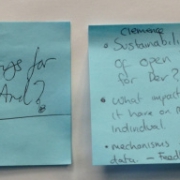Green Alternatives to Diesel Powered Mobile Base Stations
As cellular networks continue to expand throughout the developing world, mobile base stations are increasingly located in rural areas that are often difficult to reach and not connected to electrical grids. As a result, an estimated 640,000 base stations around the world are off-grid. Diesel generators power most of these, but other options exist. This article is the first in a series looking at the relationship between mobile networks and energy. In this entry we take a look at the issues of diesel power and near term possibilities for greener, more sustainable options.
The pervasive use of diesel generators introduces a number of risk factors including fuel prices, operational efficiencies, and environmental liabilities. While specific prices will vary by location and subsidy, diesel prices mirror the crude market, which has increasingly fluctuated in recent years to roughly 3 times the price a decade or so ago. Costs related to fuel transportation are also problematic. According to the World Bank, this has resulted in diesel pump prices in India increasing from US 21 cents to 86 cents per liter in the fourteen years leading up to 2012. As cell tower base stations are located in increasingly remote areas, it will require additional effort and cost to deliver replacement fuel. Diesel generators have long been the reliable power source of choice. However, in a future with unpredictable fuel costs and many remote base stations, the search for cost effective and reliable power may lead elsewhere.
Running diesel generators perpetually to guarantee base stations remain powered can result in reduced efficiencies and shorter generator life cycles. Diesel generators are typically sized to meet the peak demand – so service providers will opt for larger generators to ensure they can meet customer needs at all times. Diesel generators however, operate at lower efficiencies when the demand is significantly lower than what they are designed to handle. When operated consistently in these lower ranges, diesel generators are likely to require additional maintenance and may suffer reduced lifespans. In order to meet the industry hallmark of guaranteed service, the service providers are incentivized to power their base stations with inherently inefficient generator operations. This practice reduces the useful electricity generated per unit of fuel, and leads to additional fuel and operational expenses, putting long-term business models at risk.
Fortunately, a number of near term options exist that can improve efficiency and reduce emissions, while managing additional cost implications. The average price of photovoltaic (PV) solar panels for example, has dropped precipitously since 2008 and is expected to continue to decline over the next several years, reflecting a dramatic reduction in manufacturing costs. Some estimates suggest PV solar panels could be selling to end users at roughly $0.50/W by 2017, which is expected to be competitive with mainstream technologies. Furthermore, these systems are now widely available and can be installed as the primary electricity source for cell tower base stations, retaining diesel generators for nights and cloudy days.
In addition to traditional PV solar systems, hybrid systems such as Caterpillar’s Olympian Hybrid Power System for example, provide off-the-shelf, made-to-order technology that claims to reduce fuel consumption by 30-100 percent, with a pay back period of as little as 3 years. Another option includes adding battery storage to enhance the capacity of PV systems to serve as the primary electricity source, reducing diesel fuel use. Specialized products such as General Electric’s Durathon Battery, can be charged by hybrid systems or diesel generators to serve as the primary energy source for base stations. Even without a renewable component, this type of system could enable diesel generators to run at their peak operational level for shorter periods of time, charging the storage system and reducing the impact of low loads. While battery storage can still be costly, improved technology and near term price reductions for small and utility scale systems are expected to lower the threshold for cost competitiveness.
While diesel power continues to dominate, the greening of cellular base stations is already happening. GSMA’s Green Power for Mobile program estimates green mobile installations have almost tripled in the last three years, with 37,000 green and 26,000 diesel battery hybrid stations currently in operation around the globe. The program is pushing for the continued greening of mobile base stations, challenging the industry to power over 100,000 new and existing off-grid stations with renewable energy sources. If accomplished, this initiative could save 2.5 billion liters of diesel fuel annually, and avoid almost 7 million tonnes of carbon emission, roughly the equivalent of taking 5 million passenger vehicles in the United States off the road each year.
Despite the growth of green options and green deployments, articulating the business case for investment often remains a challenge. Although operational expenses for green systems tend to be lower and more predictable than diesel systems, the initial up front costs can be higher, which can also be compounded by unsupportive regulations and lack of local expertise. In India, for example, powering an off-grid base station costs about $14,000 using a diesel generator and $8,000 with solar plus battery back-up. By 2020 that cost differential is expected to increase to about $20,000 for diesel and $5,500 for solar. Government standards can accelerate the transition, as India is doing with their mandate that 50 percent of rural base stations and 20 percent of urban stations be powered by clean energy by 2015, increasing to 75 percent of rural and 33 percent of urban base stations by 2020. As the costs of cleaner options such as PV solar and battery storage decline however, the financial case for going green will only improve. By endorsing supportive government regulations and the development of local expertise, we can help facilitate and even accelerate the greening of the industry.
Stay tuned for the next installment in this series, where we will explore how green mobile networks could anchor efforts to extend electricity beyond the grid, into some of the world’s most rural populations.
Robin Wong is the Integra’s Spring 2014 Clean Energy Research Fellow, and student at the SIT Graduate Institute in Washington, DC. She brings over eight years of energy and project management experience, including work with the US Department of Energy. As part of her fellowship, Ms. Wong is researching the policies and practices related to clean energy initiatives of US Government development programs. She holds a Bachelor of Arts in Physics from Lawrence University, a Master of Science in Applied Physics from Cornell University, and will complete her Master of Arts in Sustainable Development in 2014, with a focus on clean energy and public private partnerships. She may be contacted at Robin.Wong@mail.sit.edu.










































